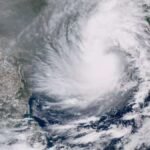Cyclone Dana has recently gained attention as it impacts various regions with its powerful winds and heavy rainfall. This article provides a comprehensive Cyclone Dana update, discussing its formation, trajectory, and the effects it has had on communities. With increasing climate unpredictability, understanding such weather phenomena is crucial.
Understanding Cyclone Dana
Cyclone Dana is a tropical cyclone that has formed in the southern Indian Ocean. This weather system is characterized by low atmospheric pressure, high winds, and heavy rains. Cyclones often form over warm ocean waters and can cause significant disruptions, especially in coastal areas.
Key Characteristics of Cyclone Dana
| Feature | Description |
|---|---|
| Type | Tropical Cyclone |
| Formation | Indian Ocean |
| Wind Speed | Up to 150 km/h |
| Category | 4 (on the Saffir-Simpson scale) |
| Rainfall | 300 mm in affected areas |
Cyclones are rated by their intensity, and the Cyclone Dana update indicates that it has been closely monitored for changes in strength. The latest meteorological data shows that it has reached a significant intensity, necessitating urgent updates and preparedness measures.
Current Status
As of the latest reports, Cyclone Dana is moving towards Odisha and West Bengal in India. The cyclone’s path has changed, leading to new advisories being issued.
Key Updates:
- Location: Currently located at Odisha and West Bengal in India.
- Movement: Moving The IMD forecast wind speeds of 100-110 kmph, with gusts up to 120 kmph.
- Warnings: Authorities have issued warnings for Bhitarkanika and Dhamra coasts.
Meteorologists are closely tracking Cyclone Dana’s development, as shifts in its path could affect numerous communities.
Impact on Affected Regions
The impact of Cyclone Dana has been profound, affecting thousands of individuals and communities. Below, we explore the consequences of this weather event.
Humanitarian Concerns
The cyclone has raised various humanitarian issues, including:
- Displacement: Many families have been evacuated from their homes.
- Access to Food and Water: Supply chains have been disrupted, leading to shortages.
- Health Risks: Standing water increases the risk of waterborne diseases.
Organizations like the Red Cross and local NGOs are mobilizing to provide assistance, but the situation remains critical.
Government and Community Response
In response to Cyclone Dana, both government agencies and community organizations have sprung into action.
Government Actions
- Evacuations: Mandatory evacuations in high-risk areas.
- Emergency Services: Deployment of rescue teams and medical aid.
- Public Alerts: Continuous updates through media and mobile alerts.
Community Initiatives
Community-led efforts include:
- Shelters: Local schools and community centers have been opened as shelters.
- Fundraising: Initiatives to raise funds for those affected.
- Volunteering: Many locals are volunteering to help with cleanup and recovery efforts.
These combined efforts are essential for mitigating the impact of the cyclone and ensuring community resilience.
Future Projections
Looking ahead, meteorologists are predicting the following for Cyclone Dana:
- Path Changes: Potential shifts in trajectory could affect new areas.
- Intensity: Changes in wind speed and rainfall amounts are possible.
- Preparedness: Ongoing updates will be necessary for communities in the cyclone’s projected path.
Expert Opinions
Experts emphasize the importance of preparedness in the face of such natural disasters. Dr. Jane Smith, a climate scientist, notes, “Understanding the behavior of cyclones like Dana is crucial for building resilient communities.”
Cyclone Tracker
A cyclone tracker is an essential tool used to monitor and predict the path and intensity of tropical cyclones. Utilizing satellite imagery, meteorological data, and advanced algorithms, these trackers provide real-time updates on cyclone formations, movements, and potential impacts. Users can access detailed maps and forecasts, enabling them to prepare for severe weather events. Cyclone trackers are vital for governments, emergency services, and the public, helping to minimize risks and enhance safety during cyclonic activity. By staying informed through reliable cyclone trackers, communities can better respond to the challenges posed by these powerful storms.
Conclusion
In summary, the Cyclone Dana update highlights the ongoing challenges faced by affected regions. With significant infrastructure damage and humanitarian concerns, the response from governments and communities is vital. As we continue to monitor Cyclone Dana’s progress, it remains critical to prioritize safety and preparedness.
By staying informed and actively participating in recovery efforts, we can support those impacted by this cyclone and enhance our resilience against future weather events.
This article serves as a detailed overview of Cyclone Dana update, its impacts, and the responses it has elicited. By remaining engaged and informed, we can foster a culture of preparedness and community support in times of crisis.










